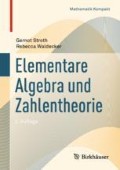Zusammenfassung
Hier setzen wir die Untersuchung der im vorherigen Kapitel begonnenen Teilbarkeitsfragen fort, allerdings wesentlich allgemeiner in beliebigen Ringen. Ein zentraler Begriff ist der des Ideals.
Access this chapter
Tax calculation will be finalised at checkout
Purchases are for personal use only
Author information
Authors and Affiliations
Corresponding author
Übungsaufgaben
Übungsaufgaben
3.1
Seien R ein kommutativer Ring mit Einselement und J ein Ideal von R. Zeige: Falls J eine Einheit von R enthält, so ist \(J=R\).
3.2
Seien R ein kommutativer Ring mit Einselement und seien I, J Ideale von R. Zeige, dass auch \(I+J\) und \(I \cap J\) Ideale von R sind.
3.3
Sei R ein Ring. Jetzt sei \(\tilde{R}:=R \times \mathbb {Z}\) und für alle \(a \in R, \lambda \in \mathbb {N}, \mu \in \mathbb {Z}\setminus \mathbb {N}_0\) sei \(\lambda \cdot a:=\underbrace{a+\ldots +a}_{\lambda -mal}\), weiterhin \(0 \cdot a:=0_R\) und \(\mu \cdot a:=(-\mu ) \cdot (-a)\).
Für alle \((a,\lambda ), (b,\mu ) \in \tilde{R}\) seien
Zeige, dass (0, 1) ein Einselement in \(\tilde{R}\) ist und dass \(\tilde{R}\) einen zu R isomorphen Teilring enthält.
3.4
Gegeben sind \(\alpha ,\beta \in \mathbb {Z}[i]\): \(\alpha :=31-2\cdot i\) und \(\beta :=6+8\cdot i\). Finde eine Darstellung eines ggT von \(\alpha \) und \(\beta \) in \(\mathbb {Z}[i]\) als Linearkombination von \(\alpha \) und \(\beta \) mit Koeffizienten aus \(\mathbb {Z}[i]\).
3.5
Sei \(R:=\mathbb {Z}/n\mathbb {Z}\), \(n\ge 2\). Zeige, dass jedes von \(0_R\) verschiedene Element in R entweder eine Einheit oder ein Nullteiler in R ist.
3.6
Zeige, dass \(K:=\mathbb {Z}[i]/3 \cdot \mathbb {Z}[i]\) ein Körper ist. Bestimme |K|.
3.7
Bestimme die Primideale von \(\mathbb {Z}/18 \mathbb {Z}\).
3.8
Sei R ein kommutativer Ring mit Eins, und sei E die Menge aller Einheiten von R. Zeige:
-
(a)
\((E, \cdot )\) ist eine Gruppe.
-
(b)
Für jedes \(e \in E\) und jeden Teiler d von e in R ist auch \(d \in E\).
3.9
Seien \(x, y \in \mathbb {Z}\) so, dass und \(y^3 = x^2 +1\) ist. Zeige, dass dann y ungerade ist und dass \(x+i\) und \(x-i\) teilerfremd sind in \(\mathbb {Z}[i]\).
3.10
Finde einen Ring R und darin unendlich viele Ideale \(J_1\), \(J_2\),.. so, dass für jedes \(i \in \mathbb {N}\) gilt: \(J_{i+1} \subsetneq J_i\).
3.11
Sei R ein Hauptidealring und seien \(a, b \in R\) teilerfremd in R. Zeige, dass R selbst das einzige Ideal von R ist, das a und b enthält.
3.12
Finde ganze Zahlen x, y wie folgt:
-
(a)
\(754x + 221y = 13\).
-
(b)
\(158x + 57y = 20000\).
3.13
Sei \(i \in \mathbb {C}\) die imaginäre Einheit, d. h. \(i^2=-1\).
Für den Ring \(R:=\mathbb {Z}[\sqrt{2}i]:=\{a+b\sqrt{2}i \mid a, b \in \mathbb {Z}\}\) sei folgende Abbildung N definiert: Für alle \(a, b \in \mathbb {Z}\) sei \(N(a+b\sqrt{2}i) := (a+b\sqrt{2}i) \cdot (a-b\sqrt{2}i)\).
-
(a)
Zeige, dass R ein Integritätsbereich und mit der Normfunktion N ein euklidischer Ring ist.
-
(b)
Berechne einen größten gemeinsamen Teiler von \(1-2\sqrt{2}i\) und \(2-\sqrt{2}i\) in R.
-
(c)
Zeige, dass 3 in R nicht irreduzibel ist.
-
(d)
Schreibe 15 als Produkt irreduzibler Elemente von R.
-
(e)
Welche Klassen assoziierter Elemente mit der Norm 9 existieren im Ring R?
Rights and permissions
Copyright information
© 2019 Springer Nature Switzerland AG
About this chapter
Cite this chapter
Stroth, G., Waldecker, R. (2019). Ringe und Ideale. In: Elementare Algebra und Zahlentheorie. Mathematik Kompakt. Birkhäuser, Cham. https://doi.org/10.1007/978-3-030-25298-4_3
Download citation
DOI: https://doi.org/10.1007/978-3-030-25298-4_3
Published:
Publisher Name: Birkhäuser, Cham
Print ISBN: 978-3-030-25297-7
Online ISBN: 978-3-030-25298-4
eBook Packages: Life Science and Basic Disciplines (German Language)

